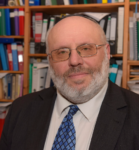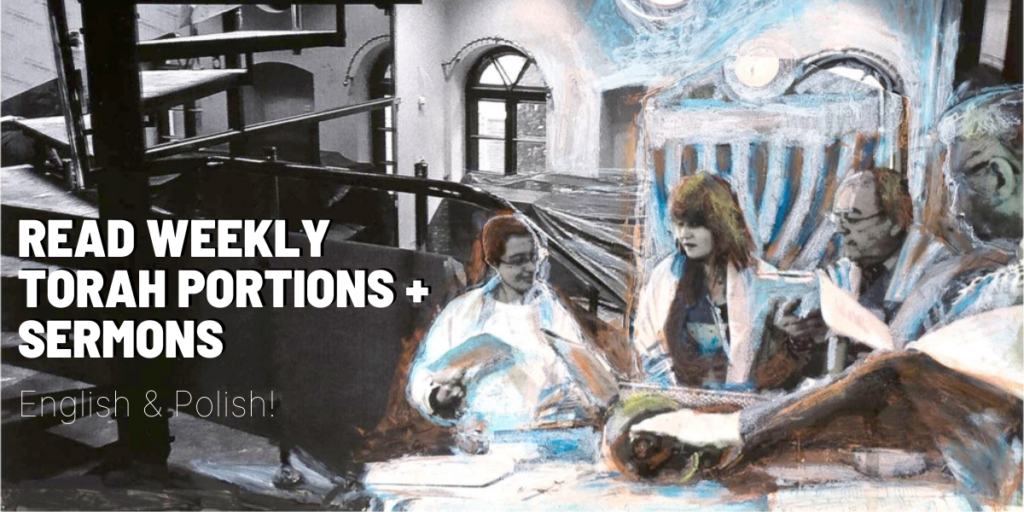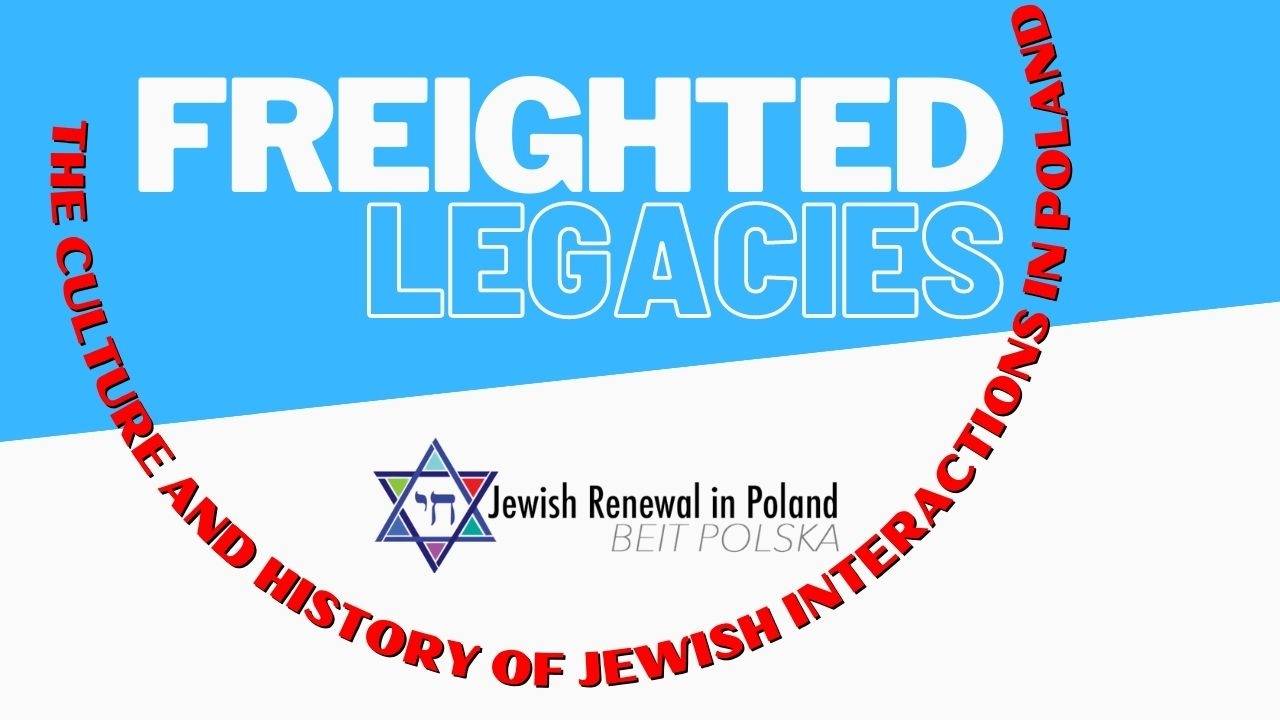9. October 2020. For Beit Warszawa

Rabbi Dr Walter Rothschild
[maxbutton id=”6″ url=”https://polishjewsreviving.org/simchat-tora-5781/” ] Simchat Torah is not really important in the Torah itself! There is a sequence of festivals starting with Rosh Hashanah and then Yom Kippur and then Sukkot, and at the end of this latter comes an ”Eighth Day marking the End, the Closure” – ‘Shemini Atzeret’. But the Rabbis of the Mishnaic period introduced – very importantly – a principle of regular readings from the Torah in their meetings – you can find details of some of the discussions in the Mishnah, Tractate Megillah – they did not refer to chapters and verses, since these were introduced into the Bible text only much later, but instead would say something like ”We start from where it says ”And Moses said…” and everyone present would know what they were talking about! Of course, being a Jewish issue, there were different opinions and different methods – the Rabbis of the diaspora of Iraq decided to read the entire Five Books through each year, whilst those in the Holy Land decided to take three years over it but – here is the point – following the same calendar, just taking in one year the first third of the ”sidra” or ”parasha”, the second year the second third, and – well, I am sure you can work out the rest. This means that in all communities the sidra ‘Bereshit’ would be read on the same week, even if in some places they read the whole lot – what we NOW call Genesis 1:1 to 6:8 – and in others only a shorter section each time. Nowadays the three-year cycle has become the norm in Progressive communities. Every now and then there are calendrical hiccups were two shorter portions have to be combined or, because a festival falls on a Shabbat, the routine cycle is disrupted.
Interestingly they decided to start and end this cycle not with Rosh Hashanah but when all the fuss of the High Holy Days with the special readings was past – i.e. at Shemini Atzeret – and significant also is that this day acquired the name, not of ‘the Day of the Torah’ but the ‘JOY of the Torah’ – Simchat Torah. This reflects to some extent the command to enjoy the entire Festival of Sukkot – ”vesamachta” – ”you shall be happy” – quite a hard thing to achieve over an entire week!
Some then said that one had to be careful not to give the (mistaken) impression that the communal joy was at having finished the Torah and so the custom arose of immediately beginning again with the first chapters of Genesis, to show that the joy is at the ability to start the next cycle of readings! This would be to some extent a Jewish equivalent of the Roman ‘Janus’ figure, facing backwards and forwards at the same time (hence the name of the month ‘January’). Other rituals also developed, such as calling up groups of people to the Aliyot or a ‘Bridegroom of the Torah’ to recite the final blessings and then another ‘Bridegroom of Bereshit’ to recite the first ones of the new cycle – once more, in Progressive communities we apply our egalitarian principles here. There would be processions (‘Hakkafot’), flags could be waved, sweets distributed to the children, and a general party could be celebrated.
There is much to be learned from this cyclical concept. For example, that if a world can have a Beginning, it can also (theoretically) have an End. Only God is eternal, not the things God has created. Also, that even if a great leader like Moses can achieve so much, he must also accept his mortality and leave the book before the actual final verse. But also, how important it is to have a book of Laws – even if they are open to interpretation, they provide a basis for our relationship to our world, our Creator and ourselves. I recently read an account of wartime atrocities in Sumatra and other parts of the Far East and one of the things that struck me was that the Japanese soldiers who drove so many Allied prisoners of war but also Indians, Malays, Thais and other slave workers to their deaths through starvation, lack of medical care, and sheer brutality, when the war was over could simply not see that they had done anything wrong. When challenged and accused of having commited war crimes they did not think of themselves as ‘evil’ or as having behaved inappropriately – this was simply what one did to prisoners over whom one had control. They had not been taught any different. We can see in European history of course many similar examples of those who considered that they were free to treat animals and ‘Untermenschen’ in any way they chose, with no sense of moral control. In this case those concerned had often been exposed to the Biblical traditions but had chosen to ignore them. Europe also saw, centuries earlier, conflicts between Christians and Heathens – those who believed in blood and the sword, who considered that one could enslave or massacre the defeated and rape their wives…. Alas there are parts of the Near East where such practices seem still to be horribly normal. What does this tell us? That a society NEEDS a book of laws and that, unless anyone can show me a truly better one from the period, the Torah is in fact the best there is, the one that teaches us to respect all of Creation, to understand how different nations with their cultures and languages, different levels of human society, rich and poor, free or slave, all have their roots in the same beginnings and that even animals have rights.
We have the Torah. When we read from it we thank God for giving it to us (not for ”having given it” to us, for the act of revealing the Torah remains a continuous process) and this Torah tells us who we are, how the world in which we live came into being, how we became a nation, how we were promised a place to settle, how we are responsible for one another, how we are to communicate to God if we wish – yes, many details are left vague and open to commentary and interpretation and circumstances sometimes change the specific details, but that is no bad thing, it is still the principle that counts. We are a people who live according to a set of laws which define who we are and how we relate to ourselves and to each other. No other human being can replace God or set himself up as God, not even a leader, not even a patriarch, not even a prophet. The Torah tells us that human beings are defined by the ability to distinguish between Good and Evil, we are not mere creatures of animal instinct – or at least, we should not be.
Law alone is not enough and the Torah is much, much more than a set of laws and ritual instructions, but these are nevertheless important to any group of people that wishes to develop and maintain its own identity. We define ourselves as a people descended from Abraham, a man chosen by God to be his messenger of monotheism, and later of those led from slavery by a man, Moses, chosen by God to lead the fugitives to the intended destination; we define ourselves by the calendar of important days in the week and in the year, by the things we choose to eat and not to eat, by the way we establish and live with our own families and with other families. Even this brief description is only a small fraction of what we have to be happy about. We read of the ability to talk to God, to plead with God and to argue with God. We read of human passions, human endeavours, human dreams and human limitations. ”Turn it this way and that way,” said the Rabbis, ”For everything is in it.” It is not a mere fundamentalist statement to agree with them. It is a statement of faith and of gratitude.
So – although this year meeting together is not permitted, nor dancing with scrolls and processing in the community, although this year the festival is to be celebrated in a much more limited, individual, isolated, socially-distanced manner – alas – we are still called upon to be Happy because: We have the Torah. Let us not underestimate what that means!
Shalom, Chag Sameach, Rabbi Dr. Walter Rothschild


















Leave a Reply